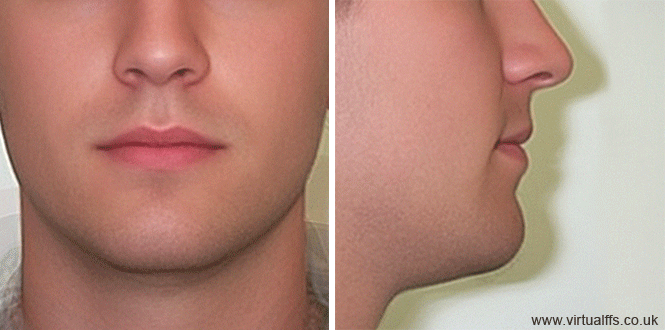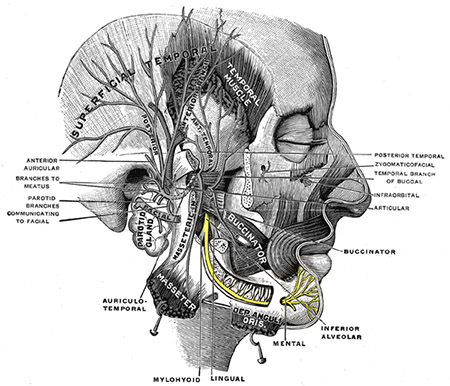Jaw
Gender Differences:
Male jaws are usually taller than female jaws. They also tend to have squarer angles at the back. However, male jaws are not, on average, wider than female jaws relative to the overall width of the face - in fact, the width of the jaw relative to the width of the cheeks (the widest part of the face) is almost exactly the same for both sexes.

Surgical Options:
1. Reducing the height of the
jaw:
If the jaw is vertically tall, a section of bone can be cut away from the
lower border. Sometimes, only a section towards the back is removed, but
in some cases, the reduction runs the full length of the jaw from corner
to corner, and including the chin.
2. Rounding the angles:
If you have very square angles, and they show clearly, you can round them
off. This is done through an incision inside the mouth, in the lower gums,
just above the jaw angles. The angles themselves can then be accessed and
cut away with a bone saw.
3. Width at the back of the jaw:
Although male jaws are not proportionately wider than female jaws, some
people have their jaws narrowed during FFS, either because they have an
excessively wide jaw, or simply because they would personally prefer
theirs to be narrower. Technically, that doesn't count as feminisation,
but because men have more volume in the lower face than women due to the
taller jaw, narrowing the jaw can give a sense of less volume in the lower
face, and that can make the face seem more feminine in some cases.
The technique used to narrow the rear of your jaw would depend on whether the width is due to bone or muscle or both.
If it is muscle then botox is a good and non-invasive way of reducing it. This is much safer, much cheaper and much less painful than trying to reduce the muscle surgically. If the width is due to bone then you would need surgery to reduce it. If the width is due to both muscle and bone, then you might need a combination of both. However, the chewing muscles will reduce on their own if some of the bone is reduced. The Botox effects may become permanent after while so you won't necessarily need to go back regularly once you've had 2 or 3 sessions.
4. Width in the mid-jaw area:
If the width is caused by the lower border of the jaw flaring out, then
removing the lower border will reduce the width. However, removing the
lower border reduces the height of the jaw too, so if you
don't need
or want to reduce the height, then some width can typically be removed
from the sides of the jaw by shaving the bone.
Facelifts and Jaw Surgery:
For older FFS patients, chin and jaw surgery can leave the soft tissues around the lower face and neck more slack than they were before. This happens partly because the bones have been reduced but also because chin and jaw surgery can cause quite a lot of swelling and that swelling stretches the soft tissues. Younger patients don't have this problem as their soft tissues are very elastic and will easily tighten back up around the new jaw and chin as the swelling goes down.
The age at which you might need to consider a facelift after chin and jaw surgery will vary from person to person – one 50-year-old for example, might have very elastic soft tissues while another 40-year-old might already be having noticeable sagging.
It is very important to have
any lifting done after jaw/chin surgery and not before it, or during it.
There are 2 main reasons for this:
1. Chin and jaw surgery cause a lot of swelling and it's
impossible to know in advance how much swelling a particular patient will
experience.
2. It's not possible to know in advance how well your soft
tissues are going to adapt to the new bone structure. You can certainly
make a guess based on the patients age and by feeling how elastic the
tissues are, but there is still a lot of guesswork involved.
This means that the best way to achieve the optimum result is to wait a few months for the swelling to go down and for any re-adaptation to take place - you can then see clearly exactly what, if anything, needs to be done with the soft tissues.
And remember that you don't need to go to an FFS specialist for a facelift - there are only a handful of good FFS surgeons, but there are very many good facelift surgeons.
Hormonal effects on the jaw:
Estrogen can make your jaw narrower. It doesn't affect the jaw itself but it does reduce muscle mass, and when this shrinks the chewing muscles, it can make the jawline narrower towards the back where the muscles attach.
This means that if your jaw is too wide at the back, it's important to know if the width is due to muscle or bone. If the muscles are large, it is often worth waiting until you have been on a full dose of hormones for at least a year before you have any surgical jaw narrowing, to see if the reduction from hormones is enough to resolve the problem.
Bruxism:
If your chewing muscles are very large, it might be because you grind or clench your teeth when you are asleep. This is called "bruxism". This is often associated with anxiety which is, of course, very common in trans people. There are various treatments you could look into if bruxism is a factor in your case. These range from botox in the muscle, to relaxation techniques, to a special tooth-guard that your dentist fits to disrupt the biting reflex.
Some Questions:
Where should the incision for
jaw surgery be?
Jaw surgery incisions should always be done inside the mouth, so
I recommend that you avoid surgeons who use the old fashioned approach of
an external incisions which leaves very visible scars along your jawline.
Also see the section on the "triple approach" above.
Is it true that some surgeons
are able to use ultrasound to cut the bone?
Ultrasound is a highly advanced way of cutting bone - it's much more
accurate than a conventional bone saw, and it doesn't cause damage to the
surrounding soft tissues. That means there is less risk, much less
swelling and bruising, and that means a quicker and easier recovery with
fewer risks of complications. Not all FFS surgeons use ultrasound cutters,
so it's well worth searching for one who does.
What is the "triple approach"?
This is a way of approaching the jaw developed by Drs Daniel Simon and Luis
Capitán of
Facial Team.
Basically, when a surgeon needs to work on the whole jawline, the usual approach is to "deglove" the jaw. This involves an incision inside the mouth that runs all the way round from corner to corner. However, in the "triple approach", the surgeon makes 3 small incisions in the mouth instead - 1 on either side at the back (these are the same incisions used when working on just the jaw angles) and one at the front (this is the same incision used for chin surgery). They then tunnel between the incisions, lifting the soft tissues away from the bone, to access the whole jaw.
The advantages are firstly that there is less cutting, so it's not as traumatic for the patient, there's less swelling, and you heal more quickly. Secondly it leaves the mental nerves encased inside a large flap of soft tissue between the incisions, and that means that the nerves are well protected and you are less likely to suffer any kind of accidental injury to them.
Is a jaw reduction done by
cutting the bone, or by shaving it down?
Usually, when the surgeon has to remove bone from the bottom of the
jaw, they cut it off, but if they have to remove an area of bulging bone
from the sides of the jaw,
they shave it down.
I am young and have no
sagging but my surgeon says I will need a facelift at the same time as jaw
surgery. Is this true?
If you are still in your 20s, you are extremely unlikely to need any
lifting as your soft tissues are almost certainly elastic enough to
re-adapt to the smaller bone structure. This is generally true for people
in their 30s too. As you get older, the chances of FFS causing some
slackness in the soft tissues become greater, but even then, you should
have the facelift several months after FFS and not during (see the section
above on facelifts and jaw surgery).
How important is the jaw in
gender recognition?
For archaeologists and forensic anthropologists it is very important
because it can often help to sex the skull, however, for the rest of us, when we are looking at someone's face, our attention is
focused much more on the eyes and mouth than the jaw, and features like square jaw angles are not only hidden around the side of the face, but are also
often hidden under a fairly thick layer of soft tissues that makes them
difficult to see.
How important is the jaw in
beauty?
Beauty is subjective so that's technically a matter of opinion, but if you
were to look at the types of female faces that are considered beautiful by
a large percentage of people at this moment in history, then wide and
square jaws seem to be important. You see this in most famously beautiful
women - examples include Gwyneth Paltrow, Penelope Cruz and Angelina Jolie:
Picture courtesy of Remy Steinegger
Can Jaw surgery cause
numbness?
The surgeon needs to be careful to avoid the “inferior alveolar nerve” which runs along inside the jaw. This nerve supplies sensation to the chin, lower incisors and bottom lip so these areas can become numb if it is damaged during surgery. Here's a diagram:

Can you do orthognathic jaw
surgery and jaw feminisation at the same time?
Generally, yes, however, orthognathic surgery is complicated and there
might be cases where the surgeon prefers to separate the procedures.